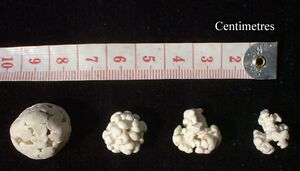Lapilli (nonfiction): Difference between revisions
No edit summary |
No edit summary |
||
| (2 intermediate revisions by the same user not shown) | |||
| Line 15: | Line 15: | ||
== In the News == | == In the News == | ||
<gallery | <gallery> | ||
</gallery> | </gallery> | ||
== Fiction cross-reference == | == Fiction cross-reference == | ||
* [[Chicxulub Chips]] | |||
* [[Crimes against geological constants]] | |||
* [[Gnomon algorithm]] | |||
* [[Gnomon Chronicles]] | |||
* [[Lapilli soup]] - soup made from lapilli | * [[Lapilli soup]] - soup made from lapilli | ||
| Line 34: | Line 38: | ||
[[Category:Geology (nonfiction)]] | [[Category:Geology (nonfiction)]] | ||
[[Category:Tephra (nonfiction)]] | [[Category:Tephra (nonfiction)]] | ||
[[Category:To do (nonfiction)]] | |||
Latest revision as of 08:33, 10 June 2019
Lapilli is a size classification term for tephra, which is material that falls out of the air during a volcanic eruption or during some meteorite impacts.
Lapilli (singular: lapillus) means "little stones" in Latin.
By definition lapilli range from 2 to 64 mm (0.08 to 2.52 in) in diameter.
A pyroclastic particle greater than 64 mm in diameter is known as a volcanic bomb when molten, or a volcanic block when solid.
Pyroclastic material with particles less than 2 mm in diameter is referred to as volcanic ash.
Lapilli are spheroid, teardrop, dumbbell- or button-shaped droplets of molten or semi-molten lava ejected from a volcanic eruption that fall to earth while still at least partially molten.
These granules are not accretionary, but instead the direct result of liquid rock cooling as it travels through the air.
In the News
Fiction cross-reference
- Chicxulub Chips
- Crimes against geological constants
- Gnomon algorithm
- Gnomon Chronicles
- Lapilli soup - soup made from lapilli
Nonfiction cross-reference
External links:
- Lapilli @ Wikipedia
